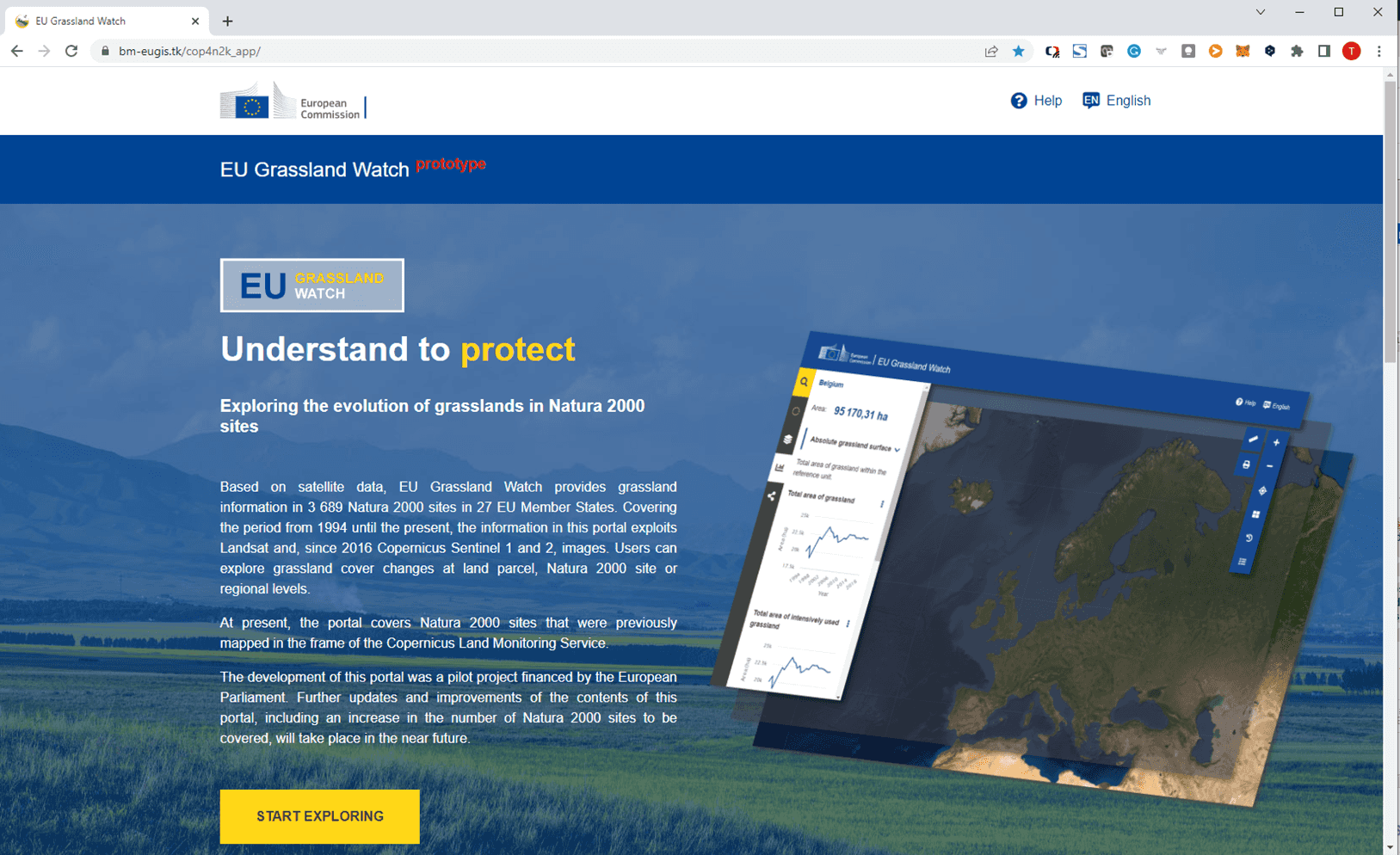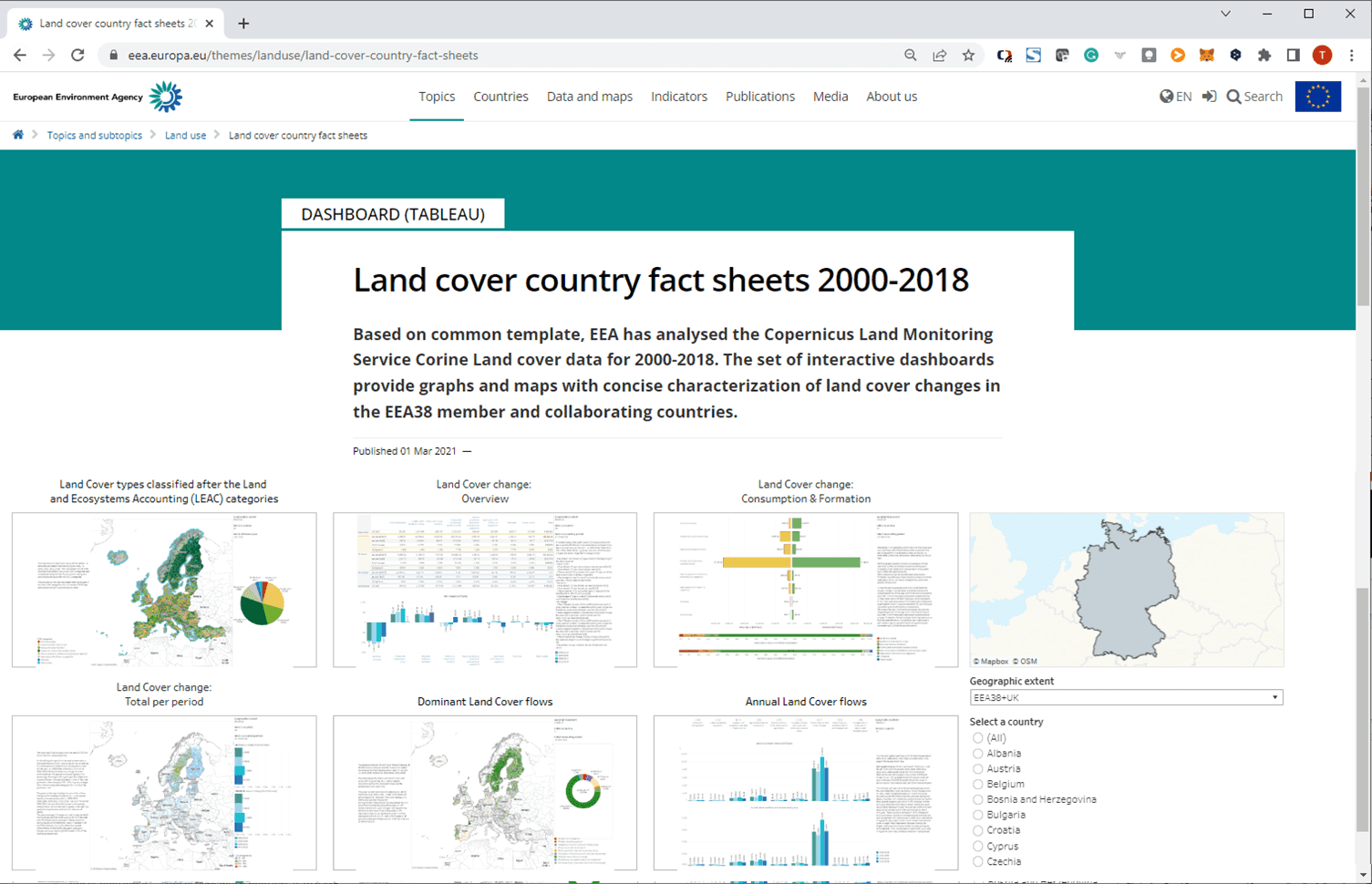Environmental monitoring and natural accounting
Environmental monitoring provides critical support for our challenging commitments targeting the resilience of ecosystems and society.
Environmental changes or disturbances are caused by human influences and natural/or ecological processes. Humans impact the physical environment in many ways: overpopulation, pollution, burning fossil fuels or deforestation. Changes like these have triggered climate change, soil erosion, biodiversity decline, poor air quality and undrinkable water.
Earth Observation data are a strong source of information for environmental monitoring and natural accounting that is essential for ecosystem monitoring, habitat mapping and biodiversity assessments. Repeated satellite measurements allow for continuous monitoring of ecosystems and are used to detect changes in distribution and to quantify the magnitude. Advances in spatial and temporal resolution of available satellite imagery mean that analysis can now be supported from global to local scales. Our solutions support many environmental applications, including the most challenging ones such targeting climate change reduction and mitigation and halting biodiversity loss, providing evidence for informed actions, improving their efficiency and targeting their impact.
Protected Areas Monitoring
Designated nature areas (at national or the European level) represent a valuable network of precious localities with specific management and dedicated protection. To maintain and improve these networks it is necessary to monitor compliance with these rules and support conservation status observation for the habitats and species present in each of the sites. Our solutions offer the effective means of such monitoring, support the evidence-based management, detection of potential weak implementation or infringement. They also help to identify potential problems early enough and to initiate discussion about the effectiveness of existing policies or strategies.

Example: EU Grassland Watch developed for European Narura 2000 sites monitoring and analysis based on CLMS Corine Land Cover data. © GISAT, s4e, Bilbomatica and Spectro Natura
Land and Ecosystem Accounting
Land and Ecosystem Accounting, as a part of natural capital accounting, provides harmonised information on the total stocks and flows of natural resources and services in a given ecosystem or region. Based on sound international methodology, our solutions provide long-term and up-to-date data on changes in land cover and land use and trace the wider environmental, social and economic implications of these transformations and their relation to human uses and functions in the landscape. Such information can subsequently support government, corporate and consumer decision making as each relates to the use or consumption of natural resources and can be used to prove the sustainable behaviour.

Example: Land Accounts prepared for European Environmental Agency based on CLMS Corine Land Cover data. ©GISAT and EEA
Increasing Land Use Carbon Storage Capacity
Contribution to CO2 in the atmosphere can be reduced by taking advantage of the fact that atmospheric CO2 can accumulate as carbon in vegetation and soils in terrestrial ecosystems. Human activities affect changes between the carbon pools and the role of Land Use, Land-Use Change and Forestry (LULUCF) activities in the mitigation of climate change has long been recognized. It identifies agriculture, forestry and other land uses as a significant net source of greenhouse gas (GHG) emissions. The mitigation can be achieved through planned activities in the LULUCF sector promoting the land use and land cover changes that increase the removals of GHGs from the atmosphere or decrease emissions by halting the loss of carbon stocks. Our solutions provide up-to-date information and guidance for such activities from a local to country perspective.
Fragmentation
Landscape fragmentation is the physical disintegration of continuous land, which is most often caused by urban or transport network expansion. Breaking structural connections between habitats results in decreased resilience of habitats and a decrease in their ability to provide various ecosystem services and support biodiversity. Thus, fragmentation is mentioned in the context of the European Green Deal as one of the main drivers of environmental challenges in the EU with respect to biodiversity loss (BDS2030). Besides biodiversity consequences, fragmentation of natural and agricultural land often leads to a change in the actual land use and thus might impact the carbon-sequestration potential in a particular area.
A large variety of fragmentation measures exists, but many of them do not address individual phases of the landscape fragmentation process in a consistent way. Based on Earth Observation data we provide operational standard indicators for fragmentation by urban and transport infrastructure expansion based on the effective mesh size and effective mesh density methodology developed at the ETH Zurich (Jaeger 2000, 2002, 2004).
Urban Sprawl
Urban sprawl affects the essential environmental, economic and social functions performed by soils and landscapes. It alters the connection with natural cycles and services, including those important for climate change mitigation and adaptation. It has also an important effect on urban planning, economic decisions, land market, mobility, accessibility and changes in lifestyle in general. As such, urban sprawl can be viewed as a typical example of a phenomenon with a cumulative effect, related also to landscape fragmentation. Similarly, urban sprawl changes the actual land use and thus the carbon sequestration potential in a particular area. Moreover, it also leads to an increase of transportation and other services costs which is an important aspect of the wider de-carbonization discussion.
We provide operational standard indicators on ‘Urban sprawl in Europe’ based on the Weighted Urban Proliferation (WUP) methodology using a composite measure of the degree of urban sprawl developed at Concordia University (Jaeger, 2010, Jaeger and Schwick, 2014). The methodology focused on three dimensions of urban sprawl: the expansion of urban areas, the dispersion of settlement areas and the density of new development (per capita/per job utilization).
Thermal comfort
Heat stress is an increasing problem in many cities around the globe due to the ongoing climate change. Citizens experience higher levels of heat stress than people living in rural areas due to dominant sealed surfaces and air temperatures, lower wind speeds and higher levels of solar and thermal radiation coming from building materials. Heat stress has a negative impact on living quality: sleep, productivity, morbidity and mortality of urban residents. It is therefore essential to have a good understanding of the factors contributing to heat stress, identifying hot spots in a city, and assessing the effectiveness of adaptation measures (e.g. green infrastructure quality addressed in Nature Based Solutions).

Example: Thermal comfort (WBGT) analysis. ©GISAT and VITO
Support to sustainable development
Humanitarian, development and reconstruction aid stakeholders are facing a lack of reliable and up-to-date information ready to support evidence-based decision making essential for distribution and targeting development and livelihood improvement activities. Satellite imagery in conjunction with open data such as Open Street Maps, World Settlement Footprint, Geonames and other local and global resources provide a baseline for application of disruptive technologies to generate actionable geo-intelligence applicable in data scarce environments.
Gisat has a proven track record of provision of geospatial services in support of humanitarian aid and development agencies, multilateral development banks and technical assistance projects in low- and middle-income countries. Over the past decade we have supported several international agencies, banks or national institutions either directly or as a qualified service provider in the scope of European Copernicus Emergency Management Service (People in Need, DG-ECHO, WFP, UNHCR, WBG, ADB, EIB, IADB etc.).
Population and IDF/Refugee mapping
Population is mapped from satellite data and other open sources to detect location, extent and evolution of various settlements (villages, hamlets, individual buildings and huts) at local to regional level. Characteristics of slum or refugee/IDP camps such as dwelling density and typology are extracted to provide qualified estimates of population distribution, density and its evolution, as well as vulnerability, deprivation levels, and to scale supporting development and rehabilitation actions.
Trafficability & accessibility
Accessibility of water (or other) resources is accomplished by mapping population distribution and analysis of transportation networks from open data, usually complemented by interpretation of satellite imagery. Settlements are categorized by typology and distance (accessibility) bands to water resources to reveal patterns of deprivation and to provide input into modelling of affected populations in response to resources’ built-up or malfunction scenarios. Transport network assessment can be facilitated by analysis of seasonal patterns related to weather, moisture or flooding probability that indicate varying trafficability throughout the season.
Impacts on agriculture and natural resources
Proxies of natural resources exploitation from pressure inflicted by population growth or large displacements, impacts of conflicts and insecurity can be measured from satellite imagery. We detect deforestation and natural vegetation withdrawal patterns, increase in soil erosion, oscillating intensity of cultivations, irrigation or fields abandonment by analysis of time series of satellite data, object-based and machine learning algorithms. Analysis is complemented by assessment of spatial and temporal association to explanatory variables such as chronology of events, seasonal conditions, topographic, positional and distance settings.
